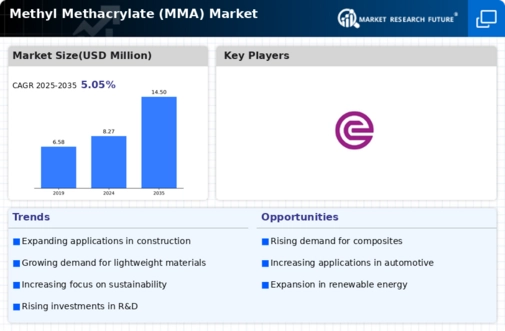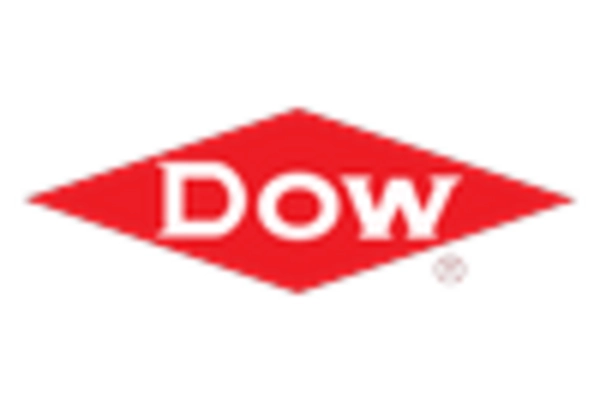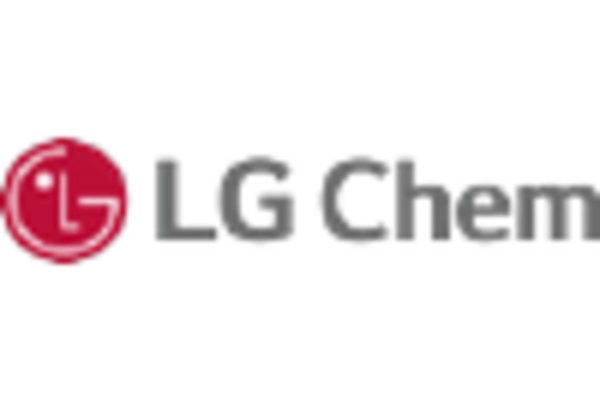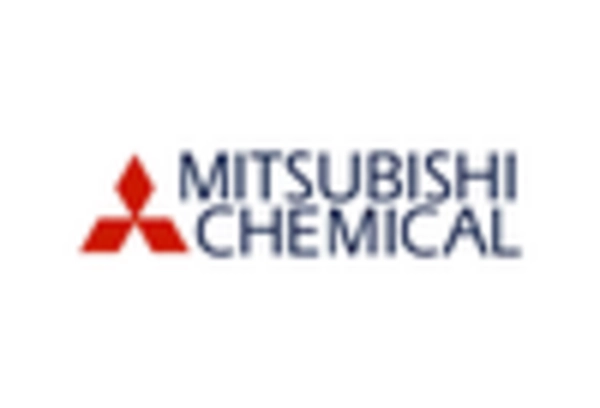-
executive summary
-
MARKET ATTRACTIVENESS ANALYSIS
- METHYL METHACRYLATE (MMA) MARKET, by Application
- METHYL METHACRYLATE (MMA) MARKET ANALYSIS BY end-use
- METHYL METHACRYLATE (MMA) MARKET, by region
-
MARKET INTRODUCTION
-
DEFINITION
-
SCOPE OF THE STUDY
-
MARKET STRUCTURE
-
RESEARCH METHODOLOGY
-
RESEARCH PROCESS
-
PRIMARY RESEARCH
-
SECONDARY RESEARCH
-
MARKET SIZE ESTIMATION
-
TOP-DOWN and BOTTOM-up APPROACH
-
FORECAST MODEL
-
LIST OF ASSUMPTIONS & LIMITATIONS
-
market dynamics
-
introduction
-
Drivers
- Increasing use of methyl methacrylate adhesives in the automobile industry
- Increasing Demand for MMA-based paints and coatings
-
restraints
- Health hazards associated with methyl methacrylate
-
opportunities
- Regulatory and policy support for waste pmma scrap recycling
-
Market factor analysis
-
supply chain analysis
- Raw Materials
- MANUFACTURERS
- Distribution & Sales channel
- end-users
-
Porter''s Five Forces Analysis
- threat of new entrants
- bargaining power of suppliers
- threat of substitutes
- bargaining power of buyers
- intensity of rivalry
-
Pricing Analysis, By Region (USD/Ton) 2019-2030
-
Supply Demand analysis
- demand analysis
- supply analysis
-
Impact of Covid-19 on the Global Methyl Methacrylate (MMA) Market
- Overview of supply and demand scenario
- Impact of COVID-19 on end-use industry
-
GLOBAL METHYL METHACRYLATE (MMA) MARKET, BY APPLICATION
-
OVERVIEW
- METHYL METHACRYLATE (MMA): MARKET ESTIMATES & FORECAST BY APPLICATION, 2019–2030
- METHYL METHACRYLATE (MMA): MARKET ESTIMATES & FORECAST BY APPLICATION, 2019–2030
-
PMMA
- PMMA: MARKET ESTIMATES & FORECAST BY region,2019–2030
- PMMA: MARKET ESTIMATES & FORECAST BY region,2019–2030
-
Surface Coatings
- Surface Coatings: MARKET ESTIMATES & FORECAST BY region,2019–2030
- Surface Coatings: MARKET ESTIMATES & FORECAST BY region,2019–2030
-
Others
- Others: MARKET ESTIMATES & FORECAST BY region,2019–2030
- Others: MARKET ESTIMATES & FORECAST BY region,2019–2030
-
GLOBAL METHYL METHACRYLATE (MMA) MARKET, BY END-USE
-
OVERVIEW
- METHYL METHACRYLATE (MMA): MARKET ESTIMATES & FORECAST BY END-USE, 2019–2030
- METHYL METHACRYLATE (MMA): MARKET ESTIMATES & FORECAST BY END-USE, 2019–2030
-
Automotive
- Automotive: MARKET ESTIMATES & FORECAST BY region,2019–2030
-
Construction
- Construction: MARKET ESTIMATES & FORECAST BY region,2019–2030
-
Electronics
- Electronics: MARKET ESTIMATES & FORECAST BY region,2019–2030
-
Others
- Others: MARKET ESTIMATES & FORECAST BY region,2019–2030
-
GLOBAL METHYL METHACRYLATE (MMA) MARKET, BY REGION
-
OVERVIEW
-
NORTH AMERICA
- US
- Canada
-
europE
- germany
- uk
- france
- russia
- italy
- SPAIN
- rest of europe
-
Asia-Pacific
- China
- Japan
- India
- South korea
- Australia & NEW zealand
- Rest of Asia-pacific
-
latin america
- brazil
- mexico
- argentina
- rest of latin america
-
middle east & Africa
- GCC Countries
- south africa
- Rest of middle east & africa
-
COMPETITIVE LANDSCAPE
-
introduction
-
Global Market Strategy Analysis
-
KEY DEVELOPMENTS and GROWTH STRATEGIES
- RECOGNITION
- Acquisition
- COLLABORATION
-
COMPANY PROFILES
-
Arkema SA
- COMPANY OVERVIEW
- FINANCIAL OVERVIEW
- PRODUCTS OFFERed
- KEY DEVELOPMENTS
- SWOT ANALYSIS
- KEY STRATEGIES
-
Sumitomo Chemical Co., Ltd.
- COMPANY OVERVIEW
- FINANCIAL OVERVIEW
- PRODUCTS OFFERed
- KEY DEVELOPMENTS
- SWOT ANALYSIS
- KEY STRATEGIES
-
Dhalop Chemicals
- COMPANY OVERVIEW
- FINANCIAL OVERVIEW
- PRODUCTS OFFERed
- KEY DEVELOPMENTS
- SWOT ANALYSIS
- KEY STRATEGIES
-
Kuraray Co. Ltd
- COMPANY OVERVIEW
- FINANCIAL OVERVIEW
- PRODUCTS OFFERed
- KEY DEVELOPMENTS
- SWOT ANALYSIS
- KEY STRATEGIES
-
Asahi Kasei Corporation
- COMPANY OVERVIEW
- FINANCIAL OVERVIEW
- PRODUCTS OFFERed
- KEY DEVELOPMENTS
- SWOT ANALYSIS
- KEY STRATEGIES
-
THE Dow Chemical Company
- COMPANY OVERVIEW
- FINANCIAL OVERVIEW
- PRODUCTS OFFERed
- KEY DEVELOPMENTS
- SWOT ANALYSIS
- KEY STRATEGIES
-
Huntsman Corporation
- COMPANY OVERVIEW
- FINANCIAL OVERVIEW
- PRODUCTS OFFERed
- KEY DEVELOPMENTS
- SWOT ANALYSIS
- KEY STRATEGIES
-
Evonik
- COMPANY OVERVIEW
- FINANCIAL OVERVIEW
- PRODUCTS OFFERed
- KEY DEVELOPMENTS
- SWOT ANALYSIS
- KEY STRATEGIES
-
LOTTE Chemical Corporation
- COMPANY OVERVIEW
- FINANCIAL OVERVIEW
- PRODUCTS OFFERed
- KEY DEVELOPMENTS
- SWOT ANALYSIS
- KEY STRATEGIES
-
Mitsubishi Chemical Corporation
- COMPANY OVERVIEW
- FINANCIAL OVERVIEW
- PRODUCTS OFFERed
- KEY DEVELOPMENTS
- SWOT ANALYSIS
- KEY STRATEGIES
-
Saudi Methacrylates Company (SAMAC)
- COMPANY OVERVIEW
- FINANCIAL OVERVIEW
- PRODUCTS OFFERed
- KEY DEVELOPMENTS
- SWOT ANALYSIS
- KEY STRATEGIES
-
APPENDIX
-
REFERENCES
-
LIST OF TABLES
-
LIST OF ASSUMPTIONS & LIMITATIONS
-
PRICING OVERVIEW, BY REGION
-
GLOBAL METHYL METHACRYLATE (MMA) MARKET, DEMAND ANALYSIS (KILOTONS) IMITATI
-
GLOBAL METHYL METHACRYLATE (MMA) MARKET, PRODUCTION (KILOTONS)
-
METHYL METHACRYLATE (MMA) MARKET ESTIMATES & FORECAST, BY APPLICATION, 2019–2030 (USD MILLION)
-
METHYL METHACRYLATE (MMA) MARKET ESTIMATES & FORECAST, BY APPLICATION, 2019–2030 (KILO TONS)
-
PMMA MARKET ESTIMATES & FORECAST, BY REGION, 2019–2030 (USD MILLION)
-
PMMA MARKET ESTIMATES & FORECAST, BY REGION, 2019–2030 (KILO TONS)
-
SURFACE COATINGS MARKET ESTIMATES & FORECAST, BY REGION, 2019–2030 (USD MILLION)
-
SURFACE COATINGS MARKET ESTIMATES & FORECAST, BY REGION, 2019–2030 (KILO TONS)
-
OTHERS MARKET ESTIMATES & FORECAST, BY REGION, 2019–2030 (USD MILLION)
-
OTHERS MARKET ESTIMATES & FORECAST, BY REGION, 2019–2030 (KILO TONS)
-
METHYL METHACRYLATE (MMA) MARKET ESTIMATES & FORECAST, BY END-USE, 2019–2030 (USD MILLION)
-
METHYL METHACRYLATE (MMA) MARKET ESTIMATES & FORECAST, BY END-USE, 2019–2030 (KILO TONS)
-
AUTOMOTIVE MARKET ESTIMATES & FORECAST, BY REGION, 2019–2030 (USD MILLION)
-
AUTOMOTIVE MARKET ESTIMATES & FORECAST, BY REGION, 2019–2030 (KILO TONS)
-
CONSTRUCTION MARKET ESTIMATES & FORECAST, BY REGION, 2019–2030 (USD MILLION)
-
CONSTRUCTION MARKET ESTIMATES & FORECAST, BY REGION, 2019–2030 (KILO TONS)
-
ELECTRONICS MARKET ESTIMATES & FORECAST, BY REGION, 2019–2030 (USD MILLION)
-
ELECTRONICS MARKET ESTIMATES & FORECAST, BY REGION, 2019–2030 (KILO TONS)
-
OTHERS MARKET ESTIMATES & FORECAST, BY REGION, 2019–2030 (USD MILLION)
-
OTHERS: MARKET ESTIMATES & FORECAST, BY REGION, 2019–2030 (KILO TONS)
-
GLOBAL METHYL METHACRYLATE (MMA) MARKET, BY REGION, 2019–2030 (USD MILLION)
-
GLOBAL METHYL METHACRYLATE (MMA) MARKET, BY REGION, 2019–2030 (KILO TONS)
-
NORTH AMERICA: METHYL METHACRYLATE MARKET SIZE, BY COUNTRY, 2019-2030 (USD MILLION)
-
NORTH AMERICA: METHYL METHACRYLATE MARKET SIZE, BY COUNTRY, 2019-2030 (TONS)
-
NORTH AMERICA METHYL METHACRYLATE MARKET ESTIMATES & FORECAST, BY APPLICATION, 2019-2030 (USD MILLION)
-
NORTH AMERICA METHYL METHACRYLATE MARKET ESTIMATES & FORECAST, BY APPLICATION, 2019-2030 (TONS)
-
NORTH AMERICA METHYL METHACRYLATE MARKET ESTIMATES & FORECAST, BY END-USE, 2019-2030 (USD MILLION)
-
NORTH AMERICA METHYL METHACRYLATE MARKET ESTIMATES & FORECAST, BY END-USE, 2019-2030 (TONS)
-
US METHYL METHACRYLATE MARKET ESTIMATES & FORECAST, BY APPLICATION, 2019-2030 (USD MILLION)
-
US METHYL METHACRYLATE MARKET ESTIMATES & FORECAST, BY APPLICATION, 2019-2030 (TONS)
-
US METHYL METHACRYLATE MARKET ESTIMATES & FORECAST, BY END-USE, 2019-2030 (USD MILLION)
-
US METHYL METHACRYLATE MARKET ESTIMATES & FORECAST, BY END-USE, 2019-2030 (TONS)
-
CANADA METHYL METHACRYLATE MARKET ESTIMATES & FORECAST, BY APPLICATION, 2019-2030 (USD MILLION)
-
CANADA METHYL METHACRYLATE MARKET ESTIMATES & FORECAST, BY APPLICATION, 2019-2030 (TONS)
-
CANADA METHYL METHACRYLATE MARKET ESTIMATES & FORECAST, BY END-USE, 2019-2030 (USD MILLION)
-
CANADA METHYL METHACRYLATE MARKET ESTIMATES & FORECAST, BY END-USE, 2019-2030 (TONS)
-
EUROPE: METHYL METHACRYLATE MARKET SIZE, BY COUNTRY, 2019-2030 (USD MILLION)
-
EUROPE: METHYL METHACRYLATE MARKET SIZE, BY COUNTRY, 2019-2030 (TONS)
-
EUROPE METHYL METHACRYLATE MARKET ESTIMATES & FORECAST, BY APPLICATION, 2019-2030 (USD MILLION)
-
EUROPE METHYL METHACRYLATE MARKET ESTIMATES & FORECAST, BY APPLICATION, 2019-2030 (TONS)
-
EUROPE METHYL METHACRYLATE MARKET ESTIMATES & FORECAST, BY END-USE, 2019-2030 (USD MILLION)
-
EUROPE METHYL METHACRYLATE MARKET ESTIMATES & FORECAST, BY END-USE, 2019-2030 (TONS)
-
GERMANY METHYL METHACRYLATE MARKET ESTIMATES & FORECAST, BY APPLICATION, 2019-2030 (USD MILLION)
-
GERMANY METHYL METHACRYLATE MARKET ESTIMATES & FORECAST, BY APPLICATION, 2019-2030 (TONS)
-
GERMANY METHYL METHACRYLATE MARKET ESTIMATES & FORECAST, BY END-USE, 2019-2030 (USD MILLION)
-
GERMANY METHYL METHACRYLATE MARKET ESTIMATES & FORECAST, BY END-USE, 2019-2030 (TONS)
-
UK METHYL METHACRYLATE MARKET ESTIMATES & FORECAST, BY APPLICATION, 2019-2030 (USD MILLION)
-
UK METHYL METHACRYLATE MARKET ESTIMATES & FORECAST, BY APPLICATION, 2019-2030 (TONS)
-
UK METHYL METHACRYLATE MARKET ESTIMATES & FORECAST, BY END-USE, 2019-2030 (USD MILLION)
-
UK METHYL METHACRYLATE MARKET ESTIMATES & FORECAST, BY END-USE, 2019-2030 (TONS)
-
FRANCE METHYL METHACRYLATE MARKET ESTIMATES & FORECAST, BY APPLICATION, 2019-2030 (USD MILLION)
-
FRANCE METHYL METHACRYLATE MARKET ESTIMATES & FORECAST, BY APPLICATION, 2019-2030 (TONS)
-
FRANCE METHYL METHACRYLATE MARKET ESTIMATES & FORECAST, BY END-USE, 2019-2030 (USD MILLION)
-
FRANCE METHYL METHACRYLATE MARKET ESTIMATES & FORECAST, BY END-USE, 2019-2030 (TONS)
-
RUSSIA METHYL METHACRYLATE MARKET ESTIMATES & FORECAST, BY APPLICATION, 2019-2030 (USD MILLION)
-
RUSSIA METHYL METHACRYLATE MARKET ESTIMATES & FORECAST, BY APPLICATION, 2019-2030 (TONS)
-
RUSSIA METHYL METHACRYLATE MARKET ESTIMATES & FORECAST, BY END-USE, 2019-2030 (USD MILLION)
-
RUSSIA METHYL METHACRYLATE MARKET ESTIMATES & FORECAST, BY END-USE, 2019-2030 (TONS)
-
ITALY METHYL METHACRYLATE MARKET ESTIMATES & FORECAST, BY APPLICATION, 2019-2030 (USD MILLION)
-
ITALY METHYL METHACRYLATE MARKET ESTIMATES & FORECAST, BY APPLICATION, 2019-2030 (TONS)
-
ITALY METHYL METHACRYLATE MARKET ESTIMATES & FORECAST, BY END-USE, 2019-2030 (USD MILLION)
-
ITALY METHYL METHACRYLATE MARKET ESTIMATES & FORECAST, BY END-USE, 2019-2030 (TONS)
-
SPAIN METHYL METHACRYLATE MARKET ESTIMATES & FORECAST, BY APPLICATION, 2019-2030 (USD MILLION)
-
SPAIN METHYL METHACRYLATE MARKET ESTIMATES & FORECAST, BY APPLICATION, 2019-2030 (TONS)
-
SPAIN METHYL METHACRYLATE MARKET ESTIMATES & FORECAST, BY END-USE, 2019-2030 (USD MILLION)
-
SPAIN METHYL METHACRYLATE MARKET ESTIMATES & FORECAST, BY END-USE, 2019-2030 (TONS)
-
REST OF EUROPE METHYL METHACRYLATE MARKET ESTIMATES & FORECAST, BY APPLICATION, 2019-2030 (USD MILLION)
-
REST OF EUROPE METHYL METHACRYLATE MARKET ESTIMATES & FORECAST, BY APPLICATION, 2019-2030 (TONS)
-
REST OF EUROPE METHYL METHACRYLATE MARKET ESTIMATES & FORECAST, BY END-USE, 2019-2030 (USD MILLION)
-
REST OF EUROPE METHYL METHACRYLATE MARKET ESTIMATES & FORECAST, BY END-USE, 2019-2030 (TONS)
-
ASIA-PACIFIC: METHYL METHACRYLATE (MMA) MARKET, BY COUNTRY, 2019–2030 (USD MILLION)
-
ASIA-PACIFIC: METHYL METHACRYLATE (MMA) MARKET, BY COUNTRY, 2019–2030 (KILO TONS)
-
ASIA-PACIFIC: METHYL METHACRYLATE (MMA) MARKET, BY APPLICATION, 2019–2030 (USD MILLION)
-
ASIA-PACIFIC: METHYL METHACRYLATE (MMA) MARKET, BY APPLICATION, 2019–2030 (KILO TONS)
-
ASIA-PACIFIC: METHYL METHACRYLATE (MMA) MARKET, BY END-USE, 2019–2030 (USD MILLION)
-
ASIA-PACIFIC: METHYL METHACRYLATE (MMA) MARKET, BY END-USE, 2019–2030 (KILO TONS)
-
CHINA: METHYL METHACRYLATE (MMA) MARKET, BY APPLICATION, 2019–2030 (USD MILLION)
-
CHINA: METHYL METHACRYLATE (MMA) MARKET, BY APPLICATION, 2019–2030 (KILO TONS)
-
CHINA: METHYL METHACRYLATE (MMA) MARKET, BY END-USE, 2019–2030 (USD MILLION)
-
CHINA: METHYL METHACRYLATE (MMA) MARKET, BY END-USE, 2019–2030 (KILO TONS)
-
JAPAN: METHYL METHACRYLATE (MMA) MARKET, BY APPLICATION, 2019–2030 (USD MILLION)
-
JAPAN: METHYL METHACRYLATE (MMA) MARKET, BY APPLICATION, 2019–2030 (KILO TONS)
-
JAPAN: METHYL METHACRYLATE (MMA) MARKET, BY END-USE, 2019–2030 (USD MILLION)
-
JAPAN: METHYL METHACRYLATE (MMA) MARKET

















Leave a Comment